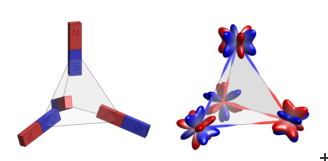Copyright 2012 neutronsources.org | All rights reserved. | Powered by FRM II | Imprint / Privacy Policy
Magnetic octupoles form a new quantum ice
Date: 21 May 2020
Source: ILL
Spin ice is a recently discovered state of matter, made of a macroscopic landscape of degenerate magnetic configurations due to the conjunction of strong Ising moments, frustrated network connectivity and ferromagnetic interactions. Spin ice is observed in some pyrochlore materials, where the magnetic moments are distributed on a network of corner-sharing tetrahedra.Owing to effective ferromagnetic interactions, two of the four magnetic moments in each tetrahedron must point inward and the two others outward. This “2 in-2 out” local constraint can be achieved by a number of ways that grows exponentially with the number of tetrahedra. In this context, the possibility of a quantum variant of spin ice has aroused a lot of attention. Such a state of matter would accommodate fluctuations between degenerate spin-ice configurations, resulting in a quantum spin liquid down to zero-temperature, with novel excitations described by emergent electrodynamics.
Thus far, theoreticians predicted that this kind of elusive quantum state of matter should exist in materials where magnetic dipole moments form the spin-ice manifold. The reality is sometimes more complex and reveals more contrasting situations. Indeed, when dealing with f-electrons, spin-orbit coupling and crystal-field effects might lead to the contribution of higher-order multipolar moments. This was theoretically suggested to be the case in cerium stannate (Ce2Sn2O7), where the single-ion ground state appears in the form of a dipole-octupole doublet.
A multi-partner neutron study led by Romain Sibille from the Paul Scherrer Institut, has shed new light on this issue, thanks to measurements performed on Ce2Sn2O7 down to the lowest temperatures, at PSI, ISIS and ILL. Powder diffraction experiments carried-out using thermal neutrons have revealed diffuse scattering that is peaked at large scattering vectors, thus indicating correlated degrees of freedom of a complex magnetization density (octupoles – see figure). Another key aspect of the work was the ability to compare this experimental result against simulations able to predict the diffuse scattering of an octupole ice manifold, which were performed by Sylvain Petit at the Laboratoire Léon Brillouin. In addition, low-energy inelastic neutron scattering measurements have shown a continuum of excitations (known as “spinons”) – a hallmark of quantum spin liquids, further supporting the conclusions drawn from the diffraction data.
Diffraction experiments of this work were performed using the powder diffractometer HRPT at the Swiss Spallation Neutron Source SINQ (Paul Scherrer Institut, Switzerland), on the time-of-flight diffractometer GEM installed at the ISIS Pulsed Neutron and Muon Source (STFC Rutherford Appleton Laboratory, UK), on the high flux-high resolution diffractometer D20 and on the D7 polarised diffractometer at the Institut Laue-Langevin (France). Inelastic measurements were carried out on the time-of-flight spectrometers MAPS and MERLIN at ISIS and on the IN4 and IN5 time-of-flight spectrometers at the ILL.
